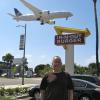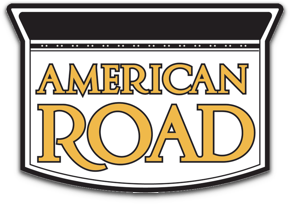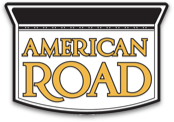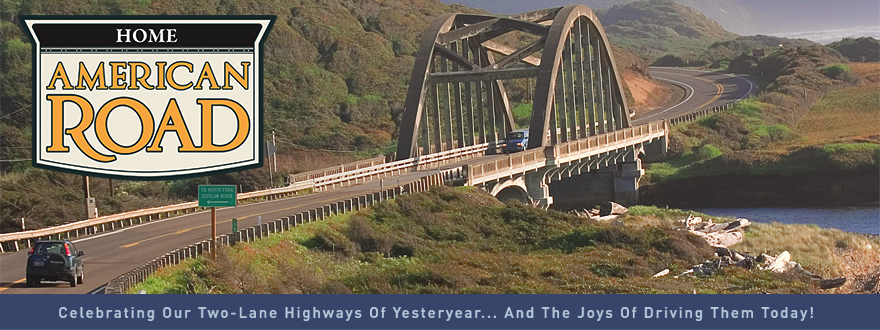-
Posts
328 -
Joined
-
Last visited
-
Days Won
4
Content Type
Profiles
Forums
Gallery
Blogs
Calendar
Everything posted by mga707
-
Roadhound, you continue to bring back pleasant memories! We hiked the Capital Gorge Road during our '93 Capital Reef/other Utah NPS sites visit. Absolutely wonderful and easy hike. Now, to your question: I have two old Utah road maps. Surprisingly, the road is signed as Utah Route 24 even on the older one, which is a mid-to-late 1930s (no date on it) Conoco map. The road is shown as an unimproved dirt road and carries the warning: "Unimproved road--carry water". It is amazing how wild and virtually roadless the entire southeast quarter of Utah was back then. There were zero miles of pavement south of US 50 and east of US 89 at that time. Capital Reef was not yet an NPS site either. The area is simply marked as "Wayne (county) Wonderland". The newer map is a Chevron map from the early-to-mid 1950s (again, no specific date). the road, and all of Utah 24, had by that time been slightly upgraded to an "improved" graded dirt or gravel road. Capital Reef has by this time been protected, but it is a much smaller area than today and is a National Monument rather than a National Park. If I recall, it and Arches were 'promoted' from Monument to Park status in the 1970s. I really enjoy your posts!
-
I drove the entire Burr Trail in '04. One of the most spectacular drives, scenery-wise, that I've ever been on. And Boulder, at least at the time that I was there, was a neat little town in a beautiful setting that had not yet been discovered/ruined/"Sedonafied"!
-

I-10 Exit Reconstruction At Old Us 80 Interchange
mga707 replied to mga707's topic in Old Spanish Trail / U.S. 80 / U.S. 90
Finally, an update from the AZ Dept. of Transportation (ADOT) on this multi-stage Marsh Station Road (old US80) interchange realignment: Early next year (2013) the old Southern Pacific (now Union Pacific) railroad bridge across Interstate 10 is scheduled to be demolished. This bridge is located just to the west of where the old Marsh Station Road overpass stood until it was demolished in 2011 (see above). Once the railroad bridge is gone, the short 65MPH section of I-10 in this area will be replaced with new pavement and a much wider median, so that it will have the same 75MPH speed limit as the rest of the highway. When this happens, the last vestige of this early (mid-1950s) limited access (freeway) section of US80/Interstate 10 will be history. Don't worry, the original two-lane 1930s old US 80 that parallels it is still there and drivable! -

Branches Of The National Parks Highway
mga707 replied to parsa9's topic in Yellowstone Trail / National Parks Highway
I have a reproduction of a 1924 Rand McNally Auto Trails map that does not show the NPH at all, so I guess it had fallen into disuse by that time, just a couple of years before the start of the Federal numbered highway system. What the map does show are three separate highway branches converging on Spokane, with the most southerly labeled as the Yellowstone Highway and the two more northerly branches being some combination of the Parks To Parks Highway, the California-Banff 'B' Line, and the Theodore Roosevelt International Highway. Then there is another highway that enters Washington from Idaho at Lewiston/Clarkston that is labeled as the Evergreen National Highway. The map does not show any road through Glacier, which jibes with what I learned from my most recent visit there: That until sometime in the 1920s there was no road connecting the east and west sides of the park. Going-to-the-Sun road was not completed until the 30s, and today's US 2 along the southern boundary of the park was not completed yet either, so motorists on the Parks To Parks or T. R. routes had to put their autos (and themselves} on the train that parallels what is now US 2 to get them from one side of the park to the other. -
Thanks! I just now noticed the one on the left edge of the picture as well.
-
Jim-- Do you know what the objects are that look like two silver (Mylar) balloons on the pole in the top right corner of the 1914 shot? I second Dave's comment above!
-
This topic prompted me to dig out an Oldsmobile history I have to find out more about the 1905 NY to Portland race. The book is titled "Setting the Pace" and was published in 1996 to commemorate the then-upcoming Olds centennial in 1997. How sad that Olds would be 'thrown under the bus' by GM less than a decade later. But I digress... The book did not disappoint. Several pages and a lot of photos are devoted to the event. I'm sure that Dave, world expert that he is, knows all of this, but I did not. The race was held to promote road construction in America, and was timed to coincide with the Good Roads Association meeting in Portland that year. Oldsmobile did indeed contribute financially to the race, to the tune of just slightly more than $4,000.00! What I found interesting was that by 1905 the five-year-old Curved Dash model was something of an anachronism, although it would continue in production for another two years. Olds had already introduced some other models that were much more 1905-modern, both in looks and in features. I surmise, though, that it's light weight, high ground clearance, and relative simplicity made it a better choice for a transcontinental race over absolutely horrible roads.
-
Wow! I've been to COTM (twice) and have driven that section of US 20, but I never knew I was so close to early road history. I know it's hard to tell, but it sure looks to me like that peaked roof Post Office building in the old photo could be the building in the Google image that sure looks like it has a peaked roof. Looks also like the track followed by the two Oldses in '05 could have gone around the other side of the hill in the map image (which I assume is Blizzard Mtn.). If so, that would put the route right in front of the building in question. Since your story and reporting is so good, I hate to nitpick, but the title of the PBS show is "Horatio's Drive". I have it on DVD. Great adventure--thanks for posting it!
-

A Surprise Arch - Hailey, Idaho
mga707 replied to Keep the Show on the Road!'s topic in State Highways & Other Roads
Love that architectural style--it just screams "1920s!", as does the illustration on it. There are local 1920s-era bungalow houses here (Tucson) that have almost that exact same style of front porch columns as the ones on the arch. Some of them are quite beautifully kept up. -

The Fires Of September - Idaho In Smoke
mga707 replied to Keep the Show on the Road!'s topic in State Highways & Other Roads
Excellent photos, thanks for posting them. Wonder why the USFS was only using 'copters, no C-130s? Terrain too rugged? Anyway, my hat is off to the fire fighters! Drove Idaho 21 from Stanley to Boise back in '09. Magnificent drive, but I have never been on any winding, mountain road with more mule deer both on and right along the highway. Scary, especially when we came upon a deer/car collision that had just happened right before we came upon it. People were stopped (car was overturned), but no ambulance/paramedics yet. They were still some miles down the road, heading up from Idaho City. I wonder if the poor guy in the car made it... -

A Place To Start The Healing
mga707 replied to roadhound's topic in Lincoln Highway / U.S. 30 / U.S. 50
That was excellent. Thank you for posting it here. -

Alex Is Old Enough To Vote...and Them Some!
mga707 replied to Keep the Show on the Road!'s topic in General Discussion
Ditto to the above, Alex. Never drove a Hudson, but the car I on which I learned to drive was a '61 Rambler American, which was a Hudson descendant (Nash+Hudson=American Motors)! -

Happy Birthday To Mobilene
mga707 replied to Keep the Show on the Road!'s topic in General Discussion
Duly seconded! Dare we ask how many? -

Upcoming Chicago-Memphis Road Trip--Tips?
mga707 replied to mga707's topic in U.S. Highways & Auto Trails
Just wanted to post a quick post-trip update. Memphis and surrounding areas were great! Some of the friendliest folks I've ever run across. Drove through Nutbush (the store/Tina Turner Museum was closed as it was late in the afternoon), checked out the Mind Field in Brownsville (bizarre but very interesting), went to both Stax and Sun in Memphis (both great!) and even enjoyed a frozen margarita on a VERY hot afternoon (100 and muggy) on Beale Street. One spur of the moment side trip that turned out to be an absolute five-star must-see, at least if one is interested in the blues or American music in general, is the Delta Blues Museum in Clarksdale MS, an hour south of Memphis along the legendary US 61. Located in Clarksdale's old train depot, it is an awesome museum. Superb! Next door is Morgan Freeman's Ground Zero blues club and restaurant, where a tasty soul food lunch was had. On the way back to Chicago, we checked out Elvis' boyhood home in Tupelo MS, then spent an enjoyable afternoon cruising the Natchez Trace Parkway up to it's northen terminus just SW of Nashville. Pulled into the Loveless Cafe just past the end of the Trace at dinnertime, but the wait was over an hour so we kept going and wound up in Clarksville for the night. The next day we hit George Rogers Clark NHP in Vincennes IN (a one county switch to Eastern Time), did a two-lane drive up the eastern side of Illinois on State Route 1 up to Interstates 74 and then 57, and then got into the Chicago area shortly after sunset. A most enjoyable road trip. -

Upcoming Chicago-Memphis Road Trip--Tips?
mga707 replied to mga707's topic in U.S. Highways & Auto Trails
Denny-- Thank you very much for all of the tips, complete with links. Much appreciated. Definitely will stop at the Loveless Cafe for some 'road food'! The Mind Field reminds me of the Watts Towers in LA! I'll be in Memphis for a convention, so my time will mostly be involved with that, but I am going to make time for some real Bar-B-Q! Have already done Graceland and Beale Street, but will hit the Stax Records site if I have time. As far as Nashville, the end of the Trace (and the Cafe) will be as close as we get this trip. Thanks again! -
Hello all--Finally, a road trip beckons! My intrepid travel companion and I are planning a Chicago-Memphis road trip starting the middle of next week. She is picking me up at MDW and we're heading south for a convention in MEM, with some road-tripping on both ends. Our basic plan is to bail off of I-57 just before leaving Illinois and cross the Ohio at Cairo, heading toward Memphis on the east side of the Mississippi via US 51. I definitely want to make a side trip to go into the little discontiguous part of Kentucky--the little bit that is separtaed from the rest of the state by the Mississippi's bends and Missouri. Maybe also take a slight detour through Nutbush, to see the town that Tina Turner (and Bob Seger) were singing about! Following our three days/four nights in Memphis, the return plan is to head down US 78/Future I-22 to Tupelo, pick up the Natchez Trace there and follow it until it's terminus west of Nashville (got to stop at the spot where Merriwether Lewis (of Lewis and Clark fame) either killed himself or was murdered, depending on which story one believes, and then head back to Chi-town through Kentucky and Indiana by basically follwing US 41 or Alternate US 41 north, via Evansville and Terre Haute. If anyone has any other spots anywhere near either part of this route that are absolute 'must stops', please share! Thanks!
-
Wow! That's a LOT of rust on poor ol' "Christine" there! Guess that vault wasn't exactly heremetically sealed...
-

Ed's Camp: Frozen In Time
mga707 replied to roadhound's topic in National Old Trails Road / Santa Fe Trail / U.S. 66
I've passed by Ed's Camp several times when taking the "scenic route" through Oatman (got to pet a burro!) on the way to or from Laughlin but have never stopped. Now I'll have to--thanks! -

Sleep In A Wigwam
mga707 replied to roadhound's topic in National Old Trails Road / Santa Fe Trail / U.S. 66
Stayed at the Holbrook Wigwam January 1/2, 1993. Even with the space heater cranked up, it was COLD!! Icy wind blew all night and all the next day while at Petrified Forest National Park. Felt colder then than I did in Barrow, Alaska, a couple of years ago! -
Dave: You came in right at the end of the push button automatic era at Chrysler Corp. Introduced for the '56 model year, I believe Chrysler abandoned them for the traditional control column stick for '64. Why, I don't know. Probably had something to do with the overall return to more GM/Ford-ish looking cars following the absolute sales debacle of the 'down-sized' 62-63 Plymouth/Dodge full-sized cars, and Virgil Exner being replaced as stytling chief by Elwood Engel, who came over from Ford (like Lee Iacocca after him, he had learned that you would never head the company if your last name was not "Ford"!). Growing up in the '60s, our family's primary car was a yellow '60 Dodge Dart Phoenix (the Dart was a full-sized model through '62, albeit a bit smaller than the Polara/Matador). It had the push buttons, which i always thought were Cool and 'space-age'! Tooling aaround Tucson yesterday, I saw a pretty '66/'67 Belvedere/Satellite (probably the latter, as it had plenty of chrome). Nice to live where old cars live on, rust-free! Mike
-

The Dandy Trail -- 88 Miles Around Indianapolis
mga707 replied to mobilene's topic in State Highways & Other Roads
Isn't David Letterman a proud Broad Ripple High School alumnus? -

Standin' On A Corner...
mga707 replied to roadhound's topic in National Old Trails Road / Santa Fe Trail / U.S. 66
Been there, done that, stood on said corner for photo op, and bought the T-shirt! La Posada is a great place to stay, and has a surprisingly good (and upscale) restaurant. I know I've plugged it before on here, but if one has any interest in historic aviation the Winslow airport (INW or KINW) is a late-1920s/early-1930s time-warp gem. Both the terminal building and adjacent hangar are from that era and largely unchanged. The old Kingman airport was of similar design (both were built under the direction of Lindbergh for TWA predecessor TAT [Transcontinental Air Transport] in preparation for their early transcontinental passenger service). Unfortunately, the old Kingman terminal was demolished sometime in the 1990s for a housing development. I always wonder what happened to the "Lindbergh Light" that was still on the roof of the old building, which had been converted to a private residence, when i visited in the mid-1980s. A genuine Lindy Light is worth big bucks today! -

Sidetrip To Canyon Diablo
mga707 replied to roadhound's topic in National Old Trails Road / Santa Fe Trail / U.S. 66
Once again, you're really making me want to do a road trip to the northern part of my state! I need some time off! Great photos. I've got to take that four mile side trip up onto "the rez" someday, complete with the typical suspension-jarring unpaved road. Sounds just like the road a bit farther north off of the paved Leupp Road (Navajo Route 15) that leads to the Grand Falls of the Little Colorado River. If one goes during a high-water time of year the falls are quite impressive--like a chocolate waterfall! Interesting that this is one area where the Old Trails Road does not exactly parallel the earlier Santa Fe tracks. -

Twin Arrows' Refurbished Arrows
mga707 replied to roadhound's topic in National Old Trails Road / Santa Fe Trail / U.S. 66
Warning--"thread creep"! But you know I can't resist when a thread turns to things that fly in the sky... Thge Vought F4U (and Goodyear FM--made under license) Corsair was one sturdy fighter. In terms of flyable WWII warbirds that are still around, it's probably second to only the P-51 Mustang. The Argentine Navy used the Corsair well into the 1970s on their one and only second-hand aircraft carrier. The bought the Corsairs from the French Aeronavale, which also kept the Corsair in service well into the jet age. Probably got the carrier from France as well! In terms of being "original" or not, it's probably not too different than a lot of restored antique autos that don't have too much original metal or wood left on them either!



